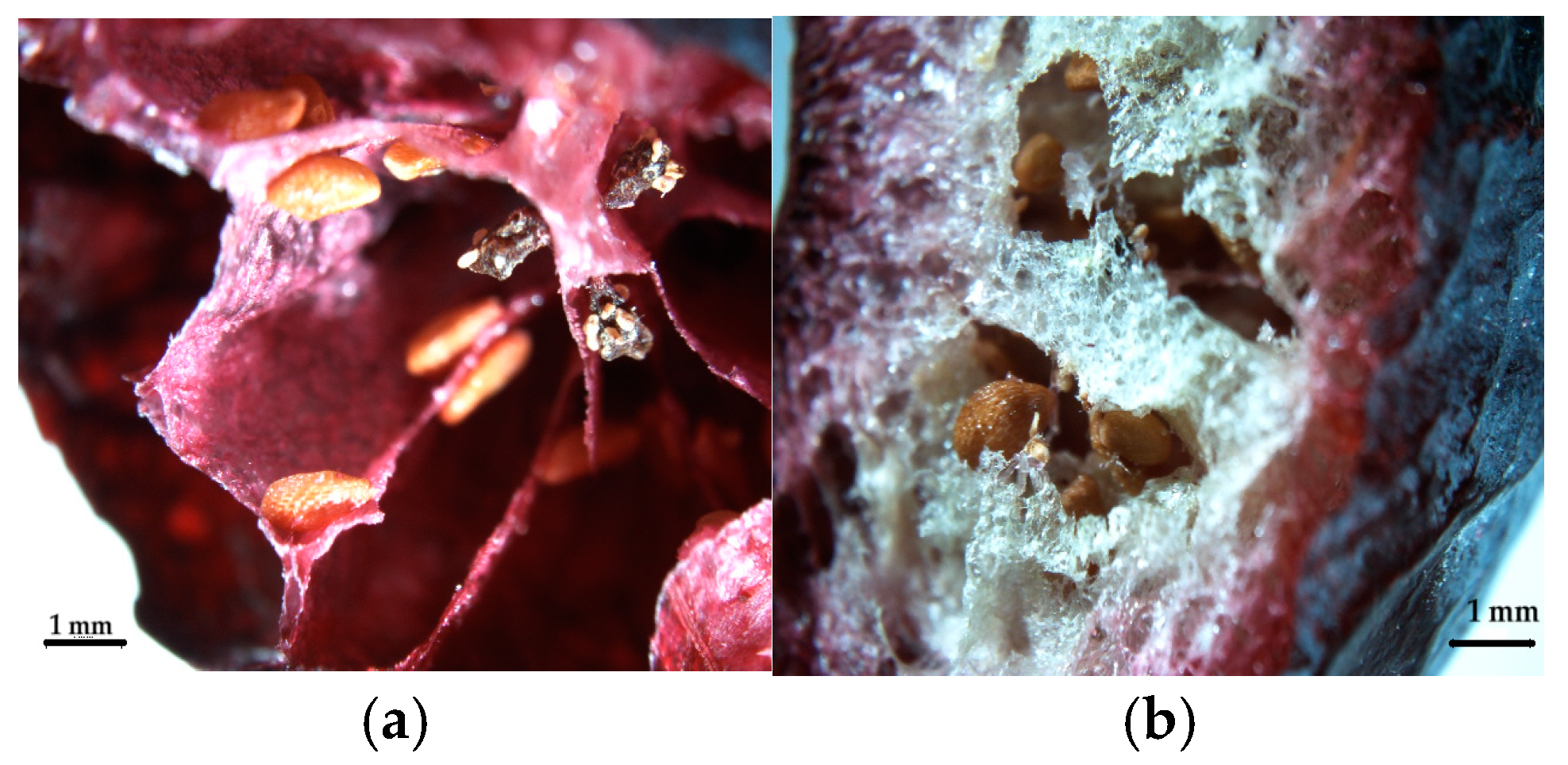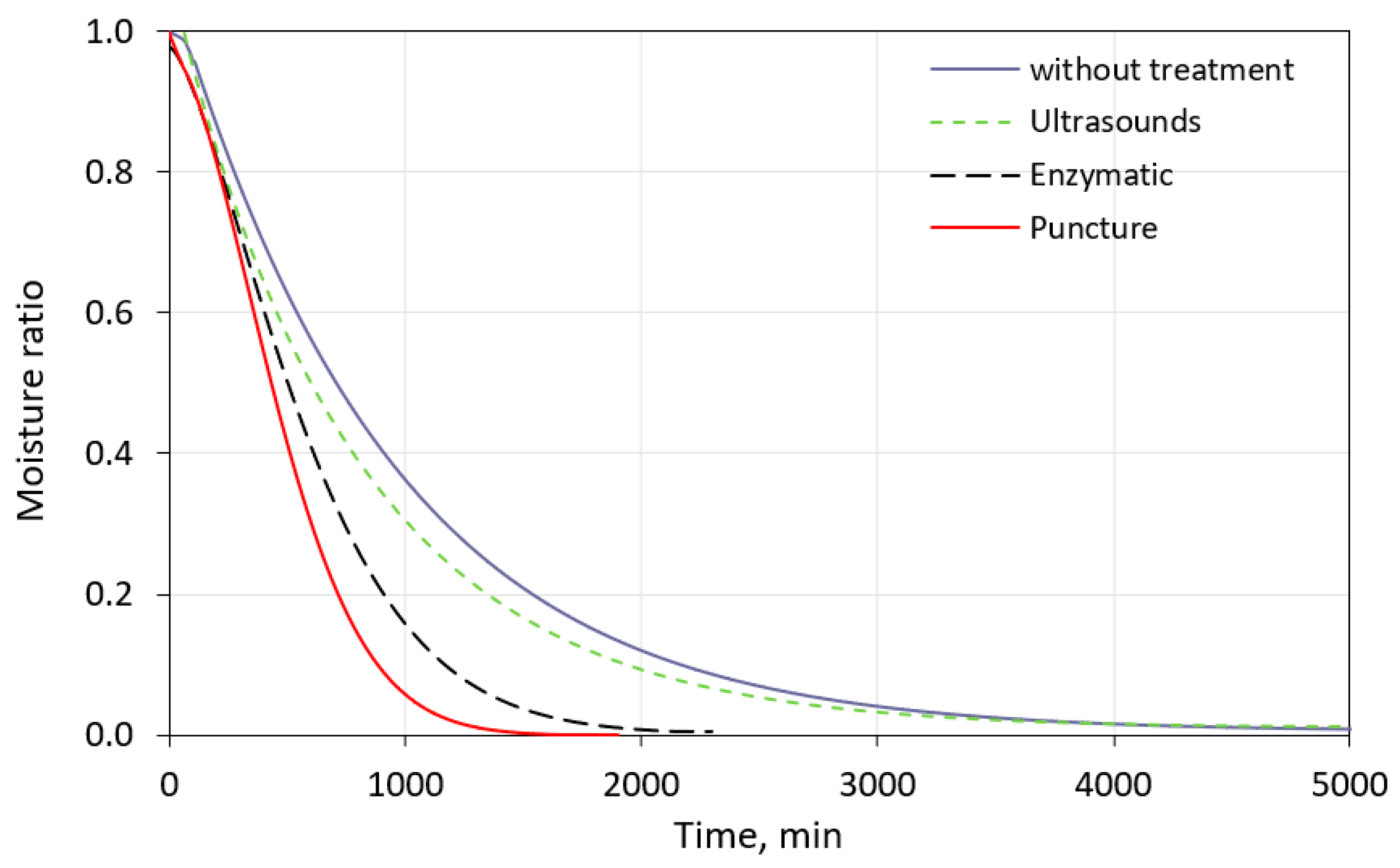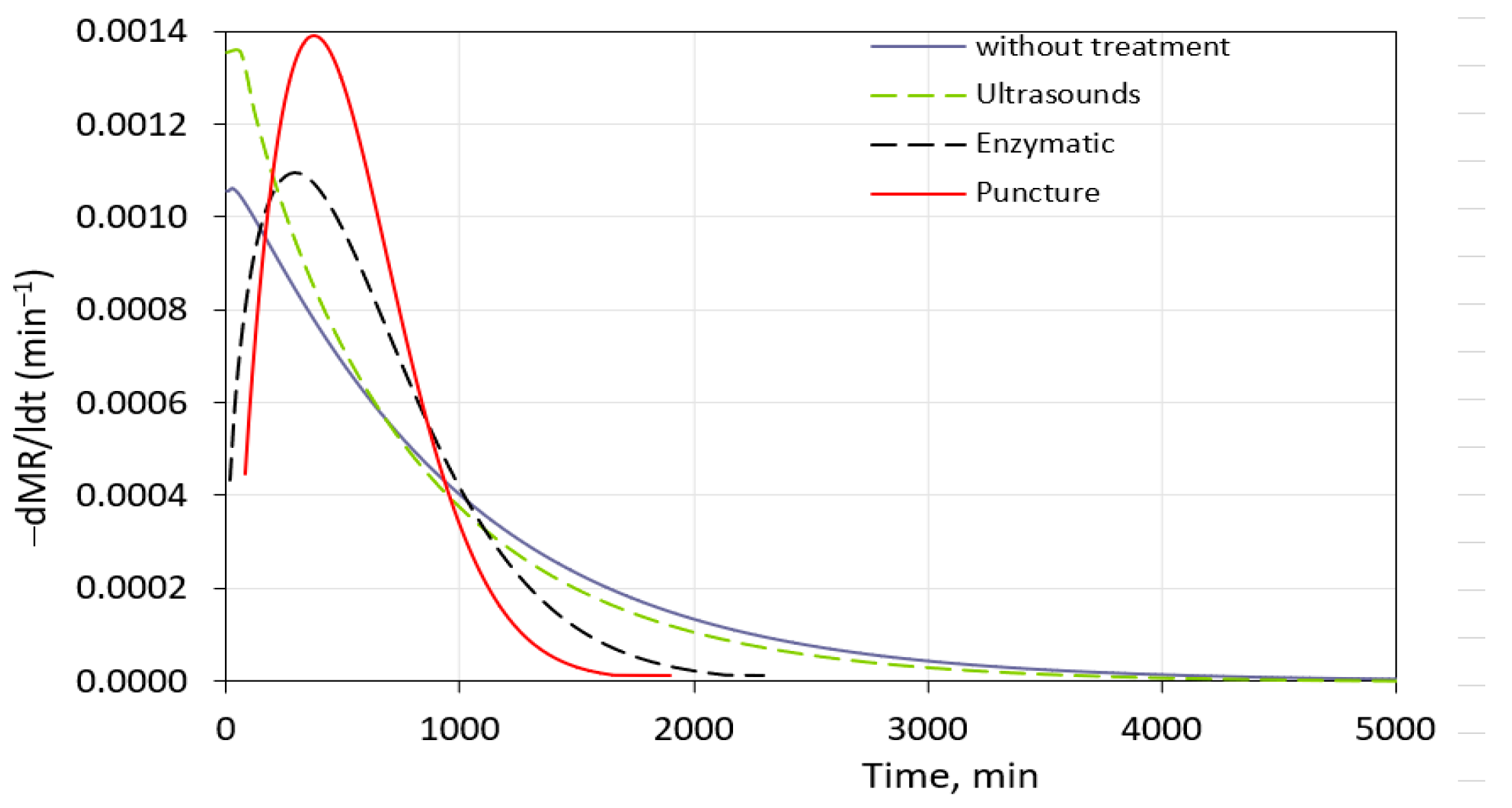Pre-Treatment Impact on Freeze-Drying Process and Properties of Dried Blueberries
Abstract
1. Introduction
2. Materials and Methods
2.1. Materials
2.2. Pre-Treatment of Blueberries Before Freeze-Drying
2.2.1. Enzymatic Treatment
2.2.2. Ultrasound Treatment
2.2.3. Puncture Treatment
2.3. Freeze-Drying
Kinetics of Drying Process
2.4. Selected Properties of Blueberries (Fresh and After Pre-Treatment and Freeze-Drying)
2.4.1. Dry Matter and Water Activity
2.4.2. Colour
2.4.3. Mechanical Resistance
2.4.4. Bioactive Compound Content
2.4.5. Hygroscopicity of Dried Fruits
2.4.6. Structure of Dried Fruits
2.5. Statistical Analysis
3. Results and Discussion
3.1. Selected Physical and Psychochemical Properties of Blueberries with Different Pre-Treatments and After Drying
3.2. Drying Kinetics of Blueberries with and Without Pre-Treatment
4. Conclusions
Author Contributions
Funding
Data Availability Statement
Conflicts of Interest
References
- Uribe, E.; Vega-Galvez, A.; Pasten, A.; Ah-Hen, K.S.; Mejias, N.; Sepúlveda, L.; Poblete, J.; Gomez-Perez, L.S. Drying: A practical technology for blueberries (Vaccinium corymbosum L.)—Processes and their effects on selected health-promoting properties. Antioxidants 2024, 13, 1554. [Google Scholar] [CrossRef]
- Aoun, A.; Ghoussoub, C.; Sarieddine, M.; Aoun, M.; El Helou, K. Effectiveness of nutritional supplements (vitamins, minerals, omega-3, and probiotics) in preventing and treating COVID-19 and viral respiratory infections. Hum. Nutr. Metab. 2024, 38, 200287. [Google Scholar] [CrossRef]
- Zhang, F.; Wang, H.; Yan, B.; Huang, L.; Zhang, H. Effects of nutritional supplementation combined with exercise training on frailty, physical function, and quality of life in chronic kidney disease: A systematic review and meta-analysis. J. Ren. Nutr. 2024; in press. [Google Scholar] [CrossRef]
- Wang, Y.; Zhu, J.; Meng, X.; Liu, S.; Mu, J.; Ning, C. Comparison of polyphenol, anthocyanin and antioxidant capacity in four varieties of Lonicera caerulea berry extracts. Food Chem. 2016, 197, 522–529. [Google Scholar] [CrossRef] [PubMed]
- Kristo, A.S.; Klimis-Zacas, D.; Sikalidis, A.K. Protective role of dietary berries in cancer. Antioxidants 2016, 5, 37. [Google Scholar] [CrossRef]
- Lachowicz-Wiśniewska, S.; Pratap-Singh, A.; Ochmian, I.; Kapusta, I.; Kotowska, A.; Pluta, S. Biodiversity in nutrients and biological activities of 14 highbush blueberry (Vaccinium corymbosum L.) cultivars. Sci. Rep. 2024, 14, 22063. [Google Scholar] [CrossRef] [PubMed]
- Sun, Y.; Zhang, M.; Mujumdar, A. Berry drying: Mechanism, pretreatment, drying technology, nutrient preservation, and mathematical models. Food Eng. Rev. 2019, 11, 61–77. [Google Scholar] [CrossRef]
- Nowak, D.; Jakubczyk, E. Effect of pulsed electric field pre-treatment and the freezing methods on the kinetics of the freeze-drying process of apple and its selected physical properties. Foods 2022, 11, 2407. [Google Scholar] [CrossRef] [PubMed]
- Nowak, D.; Jakubczyk, E. The freeze-drying of foods-the characteristic of the process course and the effect of its parameters on the physical properties of food materials. Foods 2020, 9, 1488. [Google Scholar] [CrossRef]
- Grabowski, S.; Marcotte, M.; Quan, D.; Taherian, A.R.; Zareifard, M.R.; Poirier, M.; Kudra, T. Kinetics and quality aspects of canadian blueberries and cranberries dried by osmo-convective method. Dry. Technol. 2007, 25, 367–374. [Google Scholar] [CrossRef]
- Lara, I.; Heredia, A.; Domínguez, E. Shelf life potential and the fruit cuticle: The unexpected player. Front. Plant Sci. 2019, 10, 770. [Google Scholar] [CrossRef] [PubMed]
- Ziv, C.; Zhao, Z.; Gao, Y.G.; Xia, Y. Multifunctional Roles of plant cuticle during plant-pathogen interactions. Front. Plant Sci. 2018, 9, 1088. [Google Scholar] [CrossRef] [PubMed]
- Blanke, M.M.; Leyhe, A. Stomatal Activity of the grape berry cv. Riesling, Müller-Thurgau and Ehrenfelser. J. Plant Physiol. 1987, 127, 451–460. [Google Scholar] [CrossRef]
- Blanke, M. Structure and function of blueberry fruit and flowers: Stomata, transpiration and photoassimilation. Horticulturae 2024, 10, 606. [Google Scholar] [CrossRef]
- Shi, J.; Pan, Z.; McHugh, T.H.; Wood, D.; Zhu, Y.; Avena-Bustillos, R.J.; Hirschberg, E. Effect of berry size and sodium hydroxide pretreatment on the drying characteristics of blueberries under infrared radiation heating. J. Food Sci. 2008, 73, E259–E265. [Google Scholar] [CrossRef]
- Martín-Gómez, J.; Ángeles Varo, M.; Mérida, J.; Serratosa, M.P. The influence of berry perforation on grape drying kinetics and total phenolic compounds. J. Sci. Food Agric. 2019, 99, 4260–4266. [Google Scholar] [CrossRef] [PubMed]
- Munzenmayer, P.; Ulloa, J.; Pinto, M.; Ramirez, C.; Valencia, P.; Simpson, R.; Almonacid, S. Freeze-drying of blueberries: Effects of carbon dioxide (CO2) laser perforation as skin pretreatment to improve mass transfer, primary drying time, and quality. Foods 2020, 9, 211. [Google Scholar] [CrossRef]
- Zielinska, M.; Sadowski, P.; Błaszczak, W. Freezing/thawing and microwave-assisted drying of blueberries (Vaccinium corymbosum L.). LWT 2015, 62, 555–563. [Google Scholar] [CrossRef]
- López, J.; Shun Ah-Hen, K.; Vega-Gálvez, A.; Morales, A.; García-Segovia, P.; Uribe, E. Effects of drying methods on quality attributes of murta (ugni molinae turcz) berries: Bioactivity, nutritional aspects, texture profile, microstructure and functional properties. J. Food Proc. Eng. 2017, 40, e12511. [Google Scholar] [CrossRef]
- Zhou, S.; Chen, W.; Chitrakar, B.; Fan, K. Ultrasound technology for enhancing drying efficiency and quality of fruits and vegetables: A Review. Food Bioproc. Technol. 2024, 17, 4506–4536. [Google Scholar] [CrossRef]
- Miraei Ashtiani, S.-H.; Rafiee, M.; Mohebi Morad, M.; Martynenko, A. Cold plasma pretreatment improves the quality and nutritional value of ultrasound-assisted convective drying: The case of goldenberry. Dry.Technol. 2022, 40, 1639–1657. [Google Scholar] [CrossRef]
- Jakubczyk, E.; Rybak, K.; Witrowa-Rajchert, D.; Wiktor, A.; Rąbkowski, R.; Nowacka, M. Convective drying with the application of ultrasonic pre-treatment: The effect of applied conditions on the selected properties of dried apples. Foods 2024, 13, 3893. [Google Scholar] [CrossRef] [PubMed]
- Zhang, L.; Liao, L.; Qiao, Y.; Wang, C.; Shi, D.; An, K.; Hu, J. Effects of ultrahigh pressure and ultrasound pretreatments on properties of strawberry chips prepared by vacuum-freeze drying. Food Chem. 2020, 303, 125386. [Google Scholar] [CrossRef]
- Chu, W.; Gao, H.; Chen, H.; Fang, X.; Zheng, Y. Effects of cuticular wax on the postharvest quality of blueberry fruit. Food Chem. 2018, 239, 68–74. [Google Scholar] [CrossRef]
- Montecchiarini, M.L.; Silva-Sanzana, C.; Valderramo, L.; Alemano, S.; Gollán, A.; Rivadeneira, M.F.; Bello, F.; Vázquez, D.; Blanco-Herrera, F.; Podestá, F.E.; et al. Biochemical differences in the skin of two blueberries (Vaccinium corymbosum) varieties with contrasting firmness: Implication of ions, metabolites and cell wall related proteins in two developmental stages. Plant Physiol. Biochem. 2021, 162, 483–495. [Google Scholar] [CrossRef] [PubMed]
- Yuan, T.; Zhang, D.; Li, X.; Xu, P.; Zhang, Z.; Yang, Y.; Yang, J.; He, Y.; ElGamal, R. Effect of biological enzyme pretreatment on the kinetics, microstructure, and quality of vacuum drying of wolfberry. LWT 2025, 117455. [Google Scholar] [CrossRef]
- Li, X.; Zhang, L.; Peng, Z.; Zhao, Y.; Wu, K.; Zhou, N.; Yan, Y.; Ramaswamy, H.S.; Sun, J.; Bai, W. The impact of ultrasonic treatment on blueberry wine anthocyanin color and its In-vitro anti-oxidant capacity. Food Chem. X 2020, 333, 127455. [Google Scholar] [CrossRef] [PubMed]
- Wei, Y.; Li, G.; Zhu, F. Impact of long-term ultrasound treatment on structural and physicochemical properties of starches differing in granule size. Carbohydrate Polym. 2023, 320, 121195. [Google Scholar] [CrossRef]
- Jakubczyk, E.; Jaskulska, A. The effect of freeze-drying on the properties of Polish vegetable soups. Appl. Sci. 2021, 11, 654. [Google Scholar] [CrossRef]
- Tylewicz, U.; Nowacka, M.; Rybak, K.; Drozdzal, K.; Dalla Rosa, M.; Mozzon, M. Design of healthy snack based on kiwifruit. Molecules 2020, 25, 3309. [Google Scholar] [CrossRef] [PubMed]
- Giusti, M.M.; Wrolstad, R.E. Characterization and measurement of anthocyanins by UV-visible spectroscopy. Curr. Protoc. Food Anal. Chem. 2001, 1, F1.2.1–F1.2.13. [Google Scholar] [CrossRef]
- Fijalkowska, A.; Nowacka, M.; Witrowa-Rajchert, D. The physical, optical and reconstitution properties of apples subjected to ultrasound before drying. Ital. J. Food Sci. 2017, 29, 343–356. [Google Scholar] [CrossRef]
- Nowak, K.W.; Zielinska, M.; Waszkielis, K.M. The effect of ultrasound and freezing/thawing treatment on the physical properties of blueberries. Food Sci. Biotechnol. 2019, 28, 741–749. [Google Scholar] [CrossRef] [PubMed]
- Antal, T. The effect of refrigeration and room temperature storage conditions on the physico-chemical characteristics of hybrid and freeze-dried blueberries. J. Agri. Food Res. 2024, 16, 101083. [Google Scholar] [CrossRef]
- Yemmireddy, V.K.; Chinnan, M.S.; Kerr, W.L.; Hung, Y.-C. Effect of drying method on drying time and physico-chemical properties of dried rabbiteye blueberries. LWT 2013, 50, 739–745. [Google Scholar] [CrossRef]
- Nemzer, B.; Vargas, L.; Xia, X.; Sintara, M.; Feng, H. Phytochemical and physical properties of blueberries, tart cherries, strawberries, and cranberries as affected by different drying methods. Food Chem. 2018, 262, 242–250. [Google Scholar] [CrossRef]
- Pala, Ç.U.; Zorba, N.N.; Özcan, G. Microbial inactivation and physicochemical properties of ultrasound processed pomegranate juice. J. Food Prot. 2015, 78, 531–539. [Google Scholar] [CrossRef] [PubMed]
- Buckow, R.; Kastell, A.; Terefe, N.S.; Versteeg, C. Pressure and temperature effects on degradation kinetics and storage stability of total anthocyanins in blueberry juice. J. Agric. Food Chem. 2010, 58, 10076–10084. [Google Scholar] [CrossRef] [PubMed]
- Ochmian, I.; Figiel-Kroczyńska, M.; Lachowicz, S. The quality of freeze-dried and rehydrated blueberries depending on their size and preparation for freeze-drying. Acta Univ. Cibiniensis Ser. E Food Technol. 2020, 24, 61–78. [Google Scholar] [CrossRef]
- Bieżanowska-Kopeć, R.; Piątkowska, E. Total polyphenols and antioxidant properties of selected fresh and dried herbs and spices. Appl. Sci. 2022, 12, 4876. [Google Scholar] [CrossRef]
- Sogi, D.S.; Siddiq, M.; Dolan, K.D. Total phenolics, carotenoids and antioxidant properties of Tommy Atkin mango cubes as affected by drying techniques. LWT 2015, 62, 564–568. [Google Scholar] [CrossRef]
- Capanoglu, E. Investigating the antioxidant potential of Turkish dried fruits. Int. J. Food Prop. 2014, 17, 690–702. [Google Scholar] [CrossRef]
- Siddiq, M.; Dolan, K.D.; Perkins-Veazie, P.; Collins, J.K. Effect of pectinolytic and cellulytic enzymes on the physical, chemical, and antioxidant properties of blueberry (Vaccinium corymbosum L.) juice. LWT 2018, 92, 127–132. [Google Scholar] [CrossRef]
- Lee, J.; Wrolstad, R.E. Extraction of anthocyanins and polyphenolics from blueberry processing waste. J. Food Sci. 2004, 69, 564–573. [Google Scholar] [CrossRef]
- Esquivel-Alvarado, D.; Munõz-Arrieta, R.; Alfaro-Viquez, E.; Madrigal-Carballo, S.; Krueger, C.G.; Reed, J.D. Composition of anthocyanins and proanthocyanidins in three tropical Vaccinium species from Costa Rica. J. Agric. Food Chem. 2020, 68, 2872–2879. [Google Scholar] [CrossRef]
- Kobori, R.; Yakami, S.; Kawasaki, T.; Saito, A. Changes in the polyphenol content of red raspberry fruits during ripening. Horticulturae 2021, 7, 569. [Google Scholar] [CrossRef]
- Bustos, M.C.; Rocha-Parra, D.; Sampedro, I.; de Pascual-Teresa, S.; León, A.E. The influence of different air-drying conditions on bioactive compounds and antioxidant activity of berries. J. Agric. Food Chem. 2018, 66, 2714–2723. [Google Scholar] [CrossRef] [PubMed]
- Calín-Sánchez, Á.; Kharaghani, A.; Lech, K.; Figiel, A.; Carbonell-Barrachina, Á.A.; Tsotsas, E. Drying kinetics and microstructural and sensory properties of black chokeberry (Aronia melanocarpa) as affected by drying method. Food Bioproc. Technol. 2015, 8, 63–74. [Google Scholar] [CrossRef]
- Krzykowski, A.; Dziki, D.; Rudy, S.; Polak, R.; Biernacka, B.; Gawlik-Dziki, U.; Janiszewska-Turak, E. Effect of air-drying and freeze-drying temperature on the process kinetics and physicochemical characteristics of white mulberry fruits (Morus alba L.). Processes 2023, 11, 750. [Google Scholar] [CrossRef]
- Saravacos, G.D.; Tsiourvas, D.A.; Tsami, E. Effect of temperature on the water adsorption isotherms of sultana raisins. J. Food Sci. 1986, 51, 381–383. [Google Scholar] [CrossRef]
- Adiletta, G.; Alam, M.R.; Cinquanta, L.; Russo, P.; Albanese, D.; Di Matteo, M. Effect of abrasive pretreatment on hot dried goji berry. Chem. Eng. Trans. 2015, 44, 127–132. [Google Scholar] [CrossRef]
- Stratta, L.; Capozzi, L.C.; Franzino, S.; Pisano, R. Economic analysis of a freeze-drying cycle. Processes 2020, 8, 1399. [Google Scholar] [CrossRef]
- Konopacka, D.; Płocharski, W. The effect of enzymaztic treatment on convective drying kinetics and dehydration properties of dried pumpkin, carrot and apples. Acta Agroph. 2008, 12, 699–711. [Google Scholar]




| Pre-Treatment | Dry Matter, % | Water Activity | Maximum Force, N |
|---|---|---|---|
| None | 14.6 ± 0.4 a | 0.957 ± 0.004 c | 21.4 ± 2.5 a |
| Enzymatic | 14.0 ± 0.1 b | 0.969 ± 0.007 b | 7.8 ± 1.4 b |
| Ultrasounds | 13.8 ± 0.1 b | 0.985 ± 0.009 a | 9.7 ± 3.2 b |
| Puncture | 14.5 ± 0.1 a | 0.973 ± 0.004 ab | 8.4 ± 3.0 b |
| Pre-Treatment | Dry Matter, % | Water Activity | Maximum Force, N | Hygroscopicity (Water Uptake) g/g d.m. |
|---|---|---|---|---|
| None | 95.2 ± 0.3 a | 0.267 ± 0.010 c | 107.5 ± 51.31 c | 0.15 ± 0.04 a |
| Enzymatic | 95.7 ± 0.6 a | 0.220 ± 0.010 b | 302.2 ± 94.2 a | 0.16 ± 0.03 a |
| Ultrasounds | 95.4 ± 0.3 a | 0.249 ± 0.009 a | 184.5 ± 78.6 b | 0.10 ± 0.04 a |
| Puncture | 95.0 ± 0.5 a | 0.240 ± 0.012 a | 324.2 ± 91.6 a | 0.15 ± 0.04 a |
| Parameter | Kind of Material | None | Pre-Treatment Enzymatic | Ultrasounds | Puncture |
|---|---|---|---|---|---|
| L* | Fresh | 18.60 ± 1.42 a | 19.17 ± 1.77 a | 19.97 ± 1.34 a | 19.30 ± 1.22 a |
| Dried | 22.10 ± 1.00 b | 20.63 ± 1.15 c | 19.56 ± 1.56 c | 23.44 ± 1.03 a | |
| a* | Fresh | 0.11 ± 0.12 c | 0.67 ± 0.19 b | 0.99 ± 0.47 ab | 1.42 ± 0.30 a |
| Dried | 1.44 ± 0.40 b | 2.30 ± 0.65 a | 2.91 ± 1.45 a | 2.29 ± 0.27 a | |
| b* | Fresh | −3.05 ± 0.49 b | −1.51 ± 0.41 a | −2.71 ± 0.35 b | −2.08 ± 0.43 a |
| Dried | −3.72 ± 0.49 b | −1.87 ± 0.63 a | −1.67 ± 0.62 a | −1.58 ± 0.35 a | |
| C* | Fresh | 3.06 ± 0.50 a | 1.67 ± 0.36 b | 2.93 ± 0.30 a | 2.56 ± 0.27 a |
| Dried | 4.01 ± 0.31 a | 3.03 ± 0.36 bc | 3.51 ± 1.11 ab | 2.80 ± 0.32 c |
| Pre-Treatment | Material | Flavonoids Content, mg Quercetin/g d.m. | Total Polyphenol Content mg GAE/ g d.m. | Anthocyanin mg cyj-3-glukozydu/g d.m. |
|---|---|---|---|---|
| None | Fresh | 23.8 ± 2.0 b | 41.4 ± 3.0 a | 9.8 ± 0.8 a |
| Dried | 210.8 ± 8.7 A | 223.0 ± 45.2 AB | 54.7 ± 7.5 BC | |
| Enzymatic | Fresh | 29.4 ± 0.8 a | 29.9 ± 0.7 b | 9.2 ± 0.2 a |
| Dried | 162.0 ± 29.5 B | 173.2 ± 14.5 B | 73.9 ± 1.2 A | |
| Ultrasounds | Fresh | 24.6 ± 1.8 b | 38.9 ± 0.7 a | 8.1 ± 0.1 b |
| Dried | 191.7 ± 21.6 AB | 222.3 ± 55.9 AB | 52.7± 5.2 | |
| Puncture | Fresh | 28.6 ± 0.9 a | 37.9 ± 0.6 a | 9.6 ± 0.2 a |
| Dried | 169.0 ± 25.0 B | 251.0 ± 38.0 A | 64.9 ± 4.7 B |
| Parameters | Blueberry Pre-Treatments | |||
|---|---|---|---|---|
| None | Enzymatic | Ultrasounds | Puncture | |
| a | 1.053 ± 0.001 | 0.979 ± 0.007 | 1.090 ± 0.002 | 0.977 ± 0.001 |
| 10−6 · b | 1.30 ± 0.04 | 0.62 ± 0.00 | 1.76 ± 0.07 | −1.03 ± 0.21 |
| 10−4 · k | 7.77 ± 0.04 | 0.78 ± 0.01 | 15.88 ± 0.40 | 0.21 ± 0.00 |
| n | 1.045 ± 0.002 | 1.457 ± 0.003 | 0.969 ± 0.001 | 1.709 ± 0.004 |
| R2 | 0.999 | 0.999 | 0.999 | 0.999 |
| RMSE | 0.0026 | 0.0011 | 0.0051 | 0.0024 |
| Drying time, min | 5010 ± 11 | 2180 ± 5 | 5000 ± 10 | 1930 ± 4 |
Disclaimer/Publisher’s Note: The statements, opinions and data contained in all publications are solely those of the individual author(s) and contributor(s) and not of MDPI and/or the editor(s). MDPI and/or the editor(s) disclaim responsibility for any injury to people or property resulting from any ideas, methods, instructions or products referred to in the content. |
© 2025 by the authors. Licensee MDPI, Basel, Switzerland. This article is an open access article distributed under the terms and conditions of the Creative Commons Attribution (CC BY) license (https://creativecommons.org/licenses/by/4.0/).
Share and Cite
Jakubczyk, E.; Tryzno-Gendek, E.; Kot, A.; Kamińska-Dwórznicka, A.; Nowak, D. Pre-Treatment Impact on Freeze-Drying Process and Properties of Dried Blueberries. Processes 2025, 13, 537. https://doi.org/10.3390/pr13020537
Jakubczyk E, Tryzno-Gendek E, Kot A, Kamińska-Dwórznicka A, Nowak D. Pre-Treatment Impact on Freeze-Drying Process and Properties of Dried Blueberries. Processes. 2025; 13(2):537. https://doi.org/10.3390/pr13020537
Chicago/Turabian StyleJakubczyk, Ewa, Ewelina Tryzno-Gendek, Anna Kot, Anna Kamińska-Dwórznicka, and Dorota Nowak. 2025. "Pre-Treatment Impact on Freeze-Drying Process and Properties of Dried Blueberries" Processes 13, no. 2: 537. https://doi.org/10.3390/pr13020537
APA StyleJakubczyk, E., Tryzno-Gendek, E., Kot, A., Kamińska-Dwórznicka, A., & Nowak, D. (2025). Pre-Treatment Impact on Freeze-Drying Process and Properties of Dried Blueberries. Processes, 13(2), 537. https://doi.org/10.3390/pr13020537







